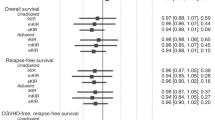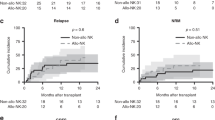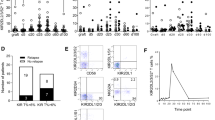Abstract
Natural killer (NK) cell subpopulations from 8 HLA-matched but killer cell immunoglobulin-like receptor (KIR)/HLA-ligand-mismatched patient–donor pairs were analyzed in the course of allogeneic hematopoietic stem cell transplantation (HCT). The patients’ post-transplantation NKG2A−/LIR-1− NK cells, which expressed only inhibitory KIRs for which the patient had no HLA class I ligands, showed higher cytotoxic capacity than the NKG2A−/LIR-1− NK cells lacking any inhibitory KIRs that remained tolerant throughout the course of HCT. The NKG2A+ NK cell subpopulations displayed the highest levels of cytotoxic activation, which appeared to be significantly enhanced in comparison with that in allogeneic graft’s donors. LIR-1− NK cells were much more frequent after HCT than LIR-1+ NK cells and LIR-1 expression on NKG2A+ or NKG2A− NK cells was associated with significantly lower cytotoxic activities. Thus NKG2A−/LIR-1− NK cells expressing only HLA-mismatched KIRs show a partial break in tolerance in the first year following HCT. The failure to exclude LIR-1+ cells within the NKG2A− NK cell subset in previous studies could explain the earlier conflicting results. Thus systemic immune activation in patients following HCT augments the GvL effect through both increasing overall NK cell activities and partially breaking tolerance of unlicensed NK cells.
This is a preview of subscription content, access via your institution
Access options
Subscribe to this journal
Receive 12 print issues and online access
$259.00 per year
only $21.58 per issue
Buy this article
- Purchase on Springer Link
- Instant access to full article PDF
Prices may be subject to local taxes which are calculated during checkout






Similar content being viewed by others
References
Ruggeri L, Capanni M, Casucci M, Volpi I, Tosti A, Perruccio K et al. Role of natural killer cell alloreactivity in HLA-mismatched hematopoietic stem cell transplantation. Blood 1999; 94: 333–339.
Ruggeri L, Capanni M, Urbani E, Perruccio K, Shlomchik WD, Tosti A et al. Effectiveness of donor natural killer cell alloreactivity in mismatched hematopoietic transplants. Science 2002; 295: 2097–2100.
Giebel S, Locatelli F, Lamparelli T, Velardi A, Davies S, Frumento G et al. Survival advantage with KIR ligand incompatibility in hematopoietic stem cell transplantation from unrelated donors. Blood 2003; 102: 814–819.
Moretta A, Bottino C, Mingari MC, Biassoni R, Moretta L . What is a natural killer cell? Nat Immunol 2002; 3: 6–8.
Lanier LL . NK cell recognition. Annu Rev Immunol 2005; 23: 225–274.
Colonna M . Inhibitory receptors: friend or foe? Lancet 2003; 361: 1067–1068.
Strauss-Albee DM, Horowitz A, Parham P, Blish CA . Coordinated regulation of NK receptor expression in the maturing human immune system. J Immunol 2014; 193: 4871–4879.
Chapman TL, Heikeman AP, Bjorkman PJ . The inhibitory receptor LIR-1 uses a common binding interaction to recognize class I MHC molecules and the viral homolog UL18. Immunity 1999; 11: 603–613.
Berg L, Riise GC, Cosman D, Bergstrom T, Olofsson S, Karre K et al. LIR-1 expression on lymphocytes, and cytomegalovirus disease in lung-transplant recipients. Lancet 2003; 361: 1099–1101.
Bjorkstrom NK, Riese P, Heuts F, Andersson S, Fauriat C, Ivarsson MA et al. Expression patterns of NKG2A, KIR, and CD57 define a process of CD56dim NK cell differentiation uncoupled from NK cell education. Blood 2010; 116: 3853–3864.
Santourlidis S, Trompeter HI, Weinhold S, Eisermann B, Meyer KL, Wernet P et al. Crucial role of DNA methylation in determination of clonally distributed killer cell Ig-like receptor expression patterns in NK cells. J Immunol 2002; 169: 4253–4261.
Uhrberg M . Shaping the human NK cell repertoire: an epigenetic glance at KIR gene regulation. Mol Immunol 2005; 42: 471–475.
Valiante NM, Uhrberg M, Shilling HG, Lienert-Weidenbach K, Arnett KL, D'Andrea A et al. Functionally and structurally distinct NK cell receptor repertoires in the peripheral blood of two human donors. Immunity 1997; 7: 739–751.
Andersson S, Fauriat C, Malmberg JA, Ljunggren HG, Malmberg KJ . KIR acquisition probabilities are independent of self-HLA class I ligands and increase with cellular KIR expression. Blood 2009; 114: 95–104.
David G, Djaoud Z, Willem C, Legrand N, Rettman P, Gagne K et al. Large spectrum of HLA-C recognition by killer Ig-like receptor (KIR)2DL2 and KIR2DL3 and restricted C1 SPECIFICITY of KIR2DS2: dominant impact of KIR2DL2/KIR2DS2 on KIR2D NK cell repertoire formation. J Immunol 2013; 191: 4778–4788.
Schonberg K, Sribar M, Enczmann J, Fischer JC, Uhrberg M . Analyses of HLA-C-specific KIR repertoires in donors with group A and B haplotypes suggest a ligand-instructed model of NK cell receptor acquisition. Blood 2011; 117: 98–107.
Hoglund P, Brodin P . Current perspectives of natural killer cell education by MHC class I molecules. Nat Rev Immunol 2010; 10: 724–734.
Orr MT, Lanier LL . Natural killer cell education and tolerance. Cell 2010; 142: 847–856.
Babor F, Fischer JC, Uhrberg M . The role of KIR genes and ligands in leukemia surveillance. Front Immunol 2013; 4: 27.
Cruz-Munoz ME, Veillette A . Do NK cells always need a license to kill? Nat Immunol 2010; 11: 279–280.
Grzywacz B, Miller JS, Verneris MR . Use of natural killer cells as immunotherapy for leukaemia. Best Pract Res Clin Haematol 2008; 21: 467–483.
Bjorklund AT, Schaffer M, Fauriat C, Ringden O, Remberger M, Hammarstedt C et al. NK cells expressing inhibitory KIR for non-self-ligands remain tolerant in HLA-matched sibling stem cell transplantation. Blood 2010; 115: 2686–2694.
Haas P, Loiseau P, Tamouza R, Cayuela JM, Moins-Teisserenc H, Busson M et al. NK cell education is shaped by donor HLA genotype after unrelated allogeneic hematopoietic stem cell transplantation. Blood 2011; 117: 1021–1029.
Leung W, Iyengar R, Turner V, Lang P, Bader P, Conn P et al. Determinants of antileukemia effects of allogeneic NK cells. J Immunol 2004; 172: 644–650.
Rathmann S, Glatzel S, Schonberg K, Uhrberg M, Follo M, Schulz-Huotari C et al. Expansion of NKG2A-LIR1- natural killer cells in HLA-matched, killer cell immunoglobulin-like receptors/HLA-ligand mismatched patients following hematopoietic cell transplantation. Biol Blood Marrow Transplant 2010; 16: 469–481.
Alter G, Malenfant JM, Altfeld M . CD107a as a functional marker for the identification of natural killer cell activity. J Immunol Methods 2004; 294: 15–22.
Foley BA, De Santis D, Van Beelen E, Lathbury LJ, Christiansen FT, Witt CS . The reactivity of Bw4+ HLA-B and HLA-A alleles with KIR3DL1: implications for patient and donor suitability for haploidentical stem cell transplantations. Blood 2008; 112: 435–443.
Draghi M, Yawata N, Gleimer M, Yawata M, Valiante NM, Parham P . Single-cell analysis of the human NK cell response to missing self and its inhibition by HLA class I. Blood 2005; 105: 2028–2035.
Moesta AK, Norman PJ, Yawata M, Yawata N, Gleimer M, Parham P . Synergistic polymorphism at two positions distal to the ligand-binding site makes KIR2DL2 a stronger receptor for HLA-C than KIR2DL3. J Immunol 2008; 180: 3969–3979.
Miller JS, Cooley S, Parham P, Farag SS, Verneris MR, McQueen KL et al. Missing KIR ligands are associated with less relapse and increased graft-versus-host disease (GVHD) following unrelated donor allogeneic HCT. Blood 2007; 109: 5058–5061.
Pende D, Marcenaro S, Falco M, Martini S, Bernardo ME, Montagna D et al. Anti-leukemia activity of alloreactive NK cells in KIR ligand-mismatched haploidentical HSCT for pediatric patients: evaluation of the functional role of activating KIR and redefinition of inhibitory KIR specificity. Blood 2009; 113: 3119–3129.
Cook MA, Milligan DW, Fegan CD, Darbyshire PJ, Mahendra P, Craddock CF et al. The impact of donor KIR and patient HLA-C genotypes on outcome following HLA-identical sibling hematopoietic stem cell transplantation for myeloid leukemia. Blood 2004; 103: 1521–1526.
Cooley S, Weisdorf DJ, Guethlein LA, Klein JP, Wang T, Le CT et al. Donor selection for natural killer cell receptor genes leads to superior survival after unrelated transplantation for acute myelogenous leukemia. Blood 2010; 116: 2411–2419.
Hsu KC, Keever-Taylor CA, Wilton A, Pinto C, Heller G, Arkun K et al. Improved outcome in HLA-identical sibling hematopoietic stem-cell transplantation for acute myelogenous leukemia predicted by KIR and HLA genotypes. Blood 2005; 105: 4878–4884.
Shilling HG, McQueen KL, Cheng NW, Shizuru JA, Negrin RS, Parham P . Reconstitution of NK cell receptor repertoire following HLA-matched hematopoietic cell transplantation. Blood 2003; 101: 3730–3740.
Verheyden S, Schots R, Duquet W, Demanet C . A defined donor activating natural killer cell receptor genotype protects against leukemic relapse after related HLA-identical hematopoietic stem cell transplantation. Leukemia 2005; 19: 1446–1451.
Kim S, Poursine-Laurent J, Truscott SM, Lybarger L, Song YJ, Yang L et al. Licensing of natural killer cells by host major histocompatibility complex class I molecules. Nature 2005; 436: 709–713.
Raulet DH, Vance RE . Self-tolerance of natural killer cells. Nat Rev Immunol 2006; 6: 520–531.
Fernandez NC, Treiner E, Vance RE, Jamieson AM, Lemieux S, Raulet DH . A subset of natural killer cells achieves self-tolerance without expressing inhibitory receptors specific for self-MHC molecules. Blood 2005; 105: 4416–4423.
Anfossi N, Andre P, Guia S, Falk CS, Roetynck S, Stewart CA et al. Human NK cell education by inhibitory receptors for MHC class I. Immunity 2006; 25: 331–342.
Vago L, Forno B, Sormani MP, Crocchiolo R, Zino E, Di Terlizzi S et al. Temporal, quantitative, and functional characteristics of single-KIR-positive alloreactive natural killer cell recovery account for impaired graft-versus-leukemia activity after haploidentical hematopoietic stem cell transplantation. Blood 2008; 112: 3488–3499.
Tarek N, Le Luduec JB, Gallagher MM, Zheng J, Venstrom JM, Chamberlain E et al. Unlicensed NK cells target neuroblastoma following anti-GD2 antibody treatment. J Clin Invest 2012; 122: 3260–3270.
Yu J, Venstrom JM, Liu XR, Pring J, Hasan RS, O'Reilly RJ et al. Breaking tolerance to self, circulating natural killer cells expressing inhibitory KIR for non-self HLA exhibit effector function after T cell-depleted allogeneic hematopoietic cell transplantation. Blood 2009; 113: 3875–3884.
Cooley S, Xiao F, Pitt M, Gleason M, McCullar V, Bergemann TL et al. A subpopulation of human peripheral blood NK cells that lacks inhibitory receptors for self-MHC is developmentally immature. Blood 2007; 110: 578–586.
Orr MT, Murphy WJ, Lanier LL . 'Unlicensed' natural killer cells dominate the response to cytomegalovirus infection. Nat Immunol 2010; 11: 321–327.
Wilhelm K, Ganesan J, Muller T, Durr C, Grimm M, Beilhack A et al. Graft-versus-host disease is enhanced by extracellular ATP activating P2X7R. Nat Med 2010; 16: 1434–1438.
Venstrom JM, Zheng J, Noor N, Danis KE, Yeh AW, Cheung IY et al. KIR and HLA genotypes are associated with disease progression and survival following autologous hematopoietic stem cell transplantation for high-risk neuroblastoma. Clin Cancer Res 2009; 15: 7330–7334.
Delgado DC, Hank JA, Kolesar J, Lorentzen D, Gan J, Seo S et al. Genotypes of NK cell KIR receptors, their ligands, and Fcgamma receptors in the response of neuroblastoma patients to Hu14.18-IL2 immunotherapy. Cancer Res 2010; 70: 9554–9561.
Prod’homme V, Griffin C, Aicheler RJ, Wang ECY, McSharry BP, Rickards CR et al. The human cytomegalovirus MHC class I homolog UL18 inhibits LIR-1+ but activates LIR-1− NK cells. J Immunol 2007; 178: 4473–4481.
Roberti MP, Julia EP, Rocca YS, Amat M, Bravo AI, Loza J et al. Overexpression of CD85j in TNBC patients inhibits Cetuximab-mediated NK cell ADCC but can be restored with CD85j functional blockade. Eur J Immunol 2015; 45: 1560–1569.
Vitale C, Chiossone L, Morreale G, Lanino E, Cottalasso F, Moretti S et al. Analysis of the activating receptors and cytolytic function of human natural killer cells undergoing in vivo differentiation after allogeneic bone marrow transplantation. Eur J Immunol 2004; 34: 455–460.
Elsner L, Flugge PF, Lozano J, Muppala V, Eiz-Vesper B, Demiroglu SY et al. The endogenous danger signals HSP70 and MICA cooperate in the activation of cytotoxic effector functions of NK cells. J Cell Mol Med 2010; 14: 992–1002.
Gallucci S, Matzinger P . Danger signals: SOS to the immune system. Curr Opin Immunol 2001; 13: 114–119.
Acknowledgements
We thank the staff of the bone marrow transplantation clinics, laboratories and Station Löhr for their assistance. We thank the José Carreras Leukämie Stiftung and the DFG for grant support. This work was supported by grants R10/34f and R13/14 from the José Carreras Leukämie Stiftung and SFB 620 Z2 from the DFG.
Author information
Authors and Affiliations
Corresponding author
Ethics declarations
Competing interests
NW is an employee of Beckman Coulter. The remaining authors declare no conflict of interest.
Rights and permissions
About this article
Cite this article
Rathmann, S., Keck, C., Kreutz, C. et al. Partial break in tolerance of NKG2A−/LIR-1− single KIR+ NK cells early in the course of HLA-matched, KIR-mismatched hematopoietic cell transplantation. Bone Marrow Transplant 52, 1144–1155 (2017). https://doi.org/10.1038/bmt.2017.81
Received:
Revised:
Accepted:
Published:
Issue Date:
DOI: https://doi.org/10.1038/bmt.2017.81



